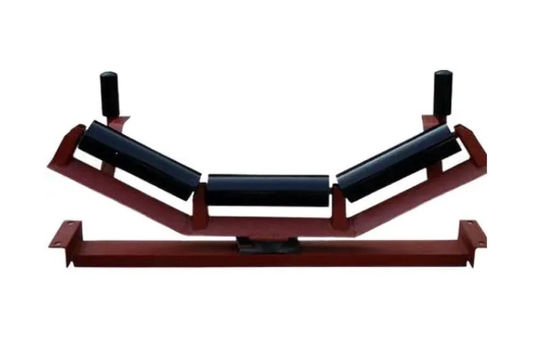

Dustproof Conveyor Carrying Roller Belt Conveyor Carrier Roller
Overview:
Belt conveyor rollers are devices used to support the conveyor belt and the materials carried on it, and to ensure the stable operation of the conveyor belt. It can be divided into many types: troughed rollers, troughed forward tilting rollers, transition rollers, parallel upper rollers, buffer rollers, self-aligning rollers, and return branch (lower branch) rollers.
Classification:
1. Conveyor Troughing Rollers: used to carry branches (upper branches), available in 35° and 45°. Generally, 35° grooved rollers are commonly used.
2. Tilt Conveyor Troughing Rollers: The side rollers of the 35° troughed idler are tilted forward 15° in the running direction to ensure good centering of the conveyor belt and make it less likely to deviate (Figure 9).
3. Transition Roller: used between the head or tail roller and the first set of grooved rollers. The conveyor belt can be gradually flattened from a flat shape to a groove or from a grooved shape to reduce the edge tension of the conveyor belt and prevent material from spreading when suddenly flattened. There are three types of transition rollers: 10°, 20°, and 30°.
4. Upper Parallel Roller: Used to transport finished items.
5. Buffer Roller: There are 35° and 45° grooved rubber ring type buffer rollers. Installed below the guide trough of the material receiving section, it can absorb the impact kinetic energy of the belt when the conveyed materials fall, extending the service life of the conveyor belt (Figure 10).
6. Self Aligning Roller: There are two types of self-aligning rollers: friction type and tapered type (see Figure 11 and Figure 12). It can prevent the conveyor belt from wandering and play the role of centering and deviation adjustment. Both upper and lower branches are available.
7. Return Branch Roller/Lower Branch Roller: flat (see Figure 13), V-shaped, V-shaped forward tilt (see Figure 14), V-shaped comb (see Figure 15), spiral (see Figure 15) Figure 16) and reverse V-shaped and other types. V-shaped and V-shaped forward-inclined lower rollers are used for larger bandwidths and can center the unloaded conveyor belt. The V-shaped and reverse V-shaped rollers are assembled together to have a better anti-deviation effect. V-shaped comb-shaped and spiral-shaped rollers can remove sticky materials attached to the conveyor belt, keep the belt surface clean, and run smoothly without deviation.
Figures:
![]()
![]()
![]()
![]()